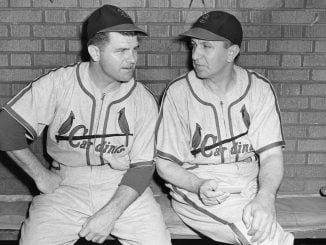
North State Journal’s 100 in 100 series will showcase the best athlete from each of North Carolina’s 100 counties. From Alamance to Yancey, each county will feature one athlete who stands above the rest. Some will be obvious choices, others controversial, but all of our choices are worthy of being recognized for their accomplishments — from the diamond and gridiron to racing ovals and the squared circle. You can see all the profiles as they’re unveiled here.

Person County
Enos “Country” Slaughter
There may never have been an athlete in any sport who embodied the personality of the team on which he played more than Enos Slaughter. A gritty, rough-and-tumble competitor described by New York Times columnist Arthur Daley as someone who “would run through a brick wall, if necessary, to make a catch, or slide into a pit of glass to score a run,” he was the heart-and-soul of a St. Louis Cardinals team known as The Gashouse Gang.
Although Slaughter also played basketball and football growing up in Roxboro, his first love was baseball. His desire to play the game professionally was so strong that he turned down a scholarship to Guilford College to take a job at a local textile mill because it had a baseball team. There, he caught the attention of the owner of the Cardinals’ farm club in Greensboro, which signed him in September 1934.
Already a fierce competitor, Slaughter developed his trademark hard-charging style after being admonished by his manager for not hustling off the field during a minor league game in Columbus, Georgia. It inspired the player called “Country Boy” because his Southern roots to always run out everything — including walks, a trait that was later copied by Pete Rose.
Slaughter made it to the majors in 1938 and stayed there for 19 seasons, interrupted by a three-year break for military service during World War II. The left-handed hitter was selected to 10 All-Star teams and played in five World Series with St. Louis and the New York Yankees. His 1,820 games, 1,148 RBI and 366 doubles still rank among the top seven in Cardinals’ history.

For all the impressive stats he compiled in a career that earned him induction into the Baseball Hall of Fame, he is best remembered for two moments — one good, one not.
The first was a “Mad Dash” that typified his playing attitude. With the score tied in the bottom of the eighth in Game 7 of the 1946 World Series against the Boston Red Sox, Slaughter took off with the pitch and never stopped running, scoring the series-winning run all the way from first on a single by teammate Harry Walker.
The other came when he and several teammates, upset over Jackie Robinson breaking baseball’s color barrier, tried to organize a boycott of games in which Robinson was on the field. Slaughter and Robinson were later involved in an incident in which Robinson was spiked on a play at first base. Slaughter insisted that the injury was the result of his hard play rather than racial animosity.
After retirement, Slaughter went into coaching, including a seven-year stretch at Duke. A statue commemorating his “Mad Dash” stands outside the Cardinals’ Busch Stadium.



